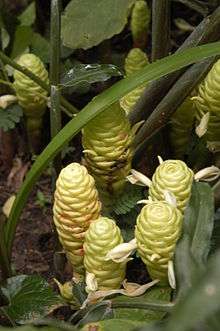Zingiber zerumbet
Zingiber zerumbet[2] is a species of plant in the ginger family[3] with leafy stems growing to about 1.2 m (3.9 ft) tall. It originates from Asia, but can be found in many tropical countries. Common names include: awapuhi, bitter ginger,[4] shampoo ginger (Malay = lempoyang) and pinecone ginger.[5]
| Zingiber zerumbet | |
|---|---|
| Scientific classification | |
| Kingdom: | Plantae |
| Clade: | Tracheophytes |
| Clade: | Angiosperms |
| Clade: | Monocots |
| Clade: | Commelinids |
| Order: | Zingiberales |
| Family: | Zingiberaceae |
| Genus: | Zingiber |
| Species: | Z. zerumbet |
| Binomial name | |
| Zingiber zerumbet (L.) Roscoe ex Sm. | |
| Synonyms[1] | |
| |
The rhizomes of Z. zerumbet have been used as food flavoring and appetizers in various cuisines while the rhizome extracts have been used in herbal medicine.
Description
Zingiber zerumbet is a perennial. From autumn until spring it goes dormant above ground as the leafy stems shrivel and die away, leaving the pale brown, creeping stems (rhizomes) at ground level. In the spring, the plant springs up anew. The 10–12 blade-shaped leaves 15–20 cm long grow in an alternate arrangement on thin, upright stem to 1.2 m (3.9 ft) tall. Among the leafy stems, the conical or club-shaped flower heads burst forth on separate and shorter stalks. These appear in the summer, after the leafy stems have been growing for a while. The flower heads are initially green and are 3 to 10 cm (1.2 to 3.9 in) long with overlapping scales, enclosing small yellowish-white flowers that poke out a few at a time. As the flower heads mature, they gradually fill with an aromatic, slimy liquid and turn a brighter red color. The flower stalks usually remain hidden beneath the leaf stalks.
Distribution and history
Z. zerumbet is native to tropical Asia and Australasia. The subspecies Zingiber zerumbet subsp. cochinchinense (Gagnep.) Triboun & K.Larsen (previously Z. cochinchinense) is found in Vietnam.[6]
Remains of Z. zerumbet have been identified at the Kuk Swamp archaeological site of New Guinea at the Phase 1 layers dated to 10,220 to 9,910 BP. However, whether it was cultivated or merely exploited from the wild is unknown. Like the ginger, the earliest evidence of its cultivation is from the Austronesian peoples who carried it with them during the Austronesian expansion (c. 5,000 BP) as canoe plants, reaching as far as Remote Oceania.[7][8][9][10][11]
Indigenous practices
The leaves and leaf stalks, which are also fragrant, were used in baking in the imu, underground oven, to enhance the flavor of pork and fish as they cooked. Traditionally, the aromatic underground rhizomes were sliced, dried, and pounded to a powder, then added to the folds of stored kapa (tapa) cloth.
Perhaps the most common use of the plant awapuhi is as a shampoo and conditioner. The clear fragrant juice present in the mature flower heads that resemble red pine cones is used for softening and bringing shininess to the hair. It can be left in the hair or rinsed out and can also be used as a massage lubricant. Hawaiian women often pick or cut the red pod flowerheads of this plant in the forest, as they approach a pool or waterfall for a refreshing summer bath, leave the flowers atop a nearby rock, and then squeeze the sweet juices into their hair and over their bodies when the swim is completed.
Gallery
References
- The Plant List: Zingiber zerumbet
- Roscoe ex Sm. (18060 In: Exot. Bot. 2: 105
- Roskov Y.; Kunze T.; Orrell T.; Abucay L.; Paglinawan L.; Culham A.; Bailly N.; Kirk P.; Bourgoin T.; Baillargeon G.; Decock W.; De Wever A. (2014). Didžiulis V. (ed.). "Species 2000 & ITIS Catalogue of Life: 2014 Annual Checklist". Species 2000: Reading, UK. Retrieved 14 July 2018.
- "Zingiber zerumbet". Natural Resources Conservation Service PLANTS Database. USDA. Retrieved 9 August 2015.
- "Floridata – Zingiber zerumbet", Retrieved 2014-03-18
- The Plant List: Zingiber zerumbet subsp. cochinchinense (retrieved 18/9/2017)
- Allaby, Robin (2007). "Origins of Plant Exploitation in Near Oceania: A Review". In Friedlaender, Jonathan S. (ed.). Genes, Language, & Culture History in the Southwest Pacific. Human Evolution Series. Oxford University Press. p. 191. ISBN 9780198041085.
- Lynch, John (2002). "Potent Roots and the Origin of kava". Oceanic Linguistics. 41 (2): 493–513. doi:10.1353/ol.2002.0010.
- McClatchey, W. (1993). "Traditional use of Curcuma longa (Zingiberaceae) in Rotuma". Economic Botany. 47 (3): 291–296. doi:10.1007/bf02862297.
- Dalby, Andrew (2002). Dangerous Tastes: The Story of Spices. University of California Press. ISBN 9780520236745.
- Ravindran, P.N.; Nirmal Babu, K. (2016). Ginger: The Genus Zingiber. CRC Press. p. 7. ISBN 9781420023367.
External links


- Details on Zingiber zerumbet
- Canoe Plants
